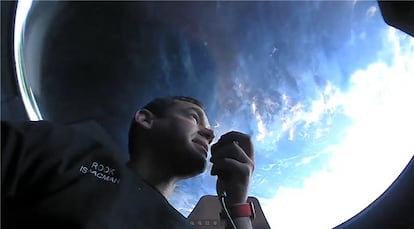Is space tourism ethical?
Not one dollar of the $200 million that billionaire Jared Isaacman reportedly spent for his private trip was left in Earth’s orbit

The private spaceflight for four tourists, commanded by billionaire Jared Isaacman on September 15, has renewed questions about the legitimacy of such trips. In this case, the flight really was for tourists, especially if compared to the space missions of Amazon founder Jeff Bezos and business magnate Richard Branson. But the questions remain the same. Not from a legal point of view – everyone has the right to spend their money on whatever they want – but rather from an ethical perspective.
In recent days, criticism of this type of activity has multiplied. The most common argument is that it is a waste of money that could have been used to address more imperative needs. It’s been a recurring criticism since the first spaceflights, particularly, of missions to the Moon. Why is this money being wasted outside of Earth, when there are so many needs on our planet?
Flying into space will always be expensive. But it is difficult to imagine how it could develop in the future
All of these very respectable opinions leave out an undeniable fact. Not one dollar of the $200 million (€172 million) that Isaacman reportedly invested in the trip was left in space. Just as not one dollar was left on the Moon half a century ago. All this money has been invested on Earth, in putting together teams of experts and specialists who have made the trip possible; in factories that have built the rockets and capsules (which are indeed recovered); in universities that have provided the theoretical foundations for the trips; and in the thousands and thousands of professionals, of all levels of qualification, who have taken part in the adventure. The space industry stimulates and absorbs enormous amounts of talent.
It is said that someone once asked the aerospace engineer Wernher von Braun: “What does going to the Moon do for us?” He replied: “For you sir, I don’t know. But for me, it has allowed me to live fairly well.” If we ignore the irony of this response, the argument was valid: 400,000 people – many of them top-level experts – took part in the Apollo space program. Such concentration of knowledge should be considered an intangible part of the national wealth of any country and perhaps this is what differentiates countries on the vanguard from those that prefer to drag behind.
But is space tourism obscenely extravagant? Perhaps it’s worthwhile to look back and try to bring out the lessons from history.
In the 1920s, after World War I had ended, dozens of young licensed pilots – now without a job – found they could make a living in flying circuses that traveled across half the American Midwest (as well as in several European countries). They scratched together a few dollars here and there offering rides to locals who had never before seen a plane. And they also came up with more risky ideas: crashing an aircraft into a barn, playing tennis on the wings of the plane, putting up a trapeze and jumping from one plane onto another in mid-flight. These were risky circus acts that had no greater goal than to entertain and frighten the spectator.
Flying circuses disappeared when the US federal government released strict norms to guarantee the safety of flights. By then, the trend had evolved to make way for air mail services, then later, the passenger airlines for short-haul trips, as well as milestones that had seemed impossible. Before crossing the Atlantic Ocean by himself and becoming a legend, Charles Lindbergh had worked for a flying circus.
The space industry stimulates and absorbs enormous amounts of talent
At the end of the 1920s, the appearance of planes with metallic airframes and the ability to hold a dozen passengers turned air transportation into a potentially profitable business. The first airlines appeared, at first privately owned, but some would go on to be funded and absorbed by the state. Pan American Airways gained importance by offering connections between the United States and South America; others, such as Imperial Airways, established the longest flight route, connecting London with Brisbane via Delhi and Bangkok. Although in the beginning passengers on this flight were mostly administrative staff of the British empire, in a few years, the number rose from a few hundred to hundreds of thousands.
Space tourism will probably never reach this level of popularity. Flying into space will always be expensive. But it is difficult to imagine how it could develop in the future. Tesla founder Elon Musk wants to colonize Mars and turn humans into a multi-planetary species, a dream that is still a long way off. More feasible is the adaptation of space capsules for long-haul trips. In this way, flying to the other side of the world would be a 45-minute trip. Of course, the ticket will not be cheap either, but who remembers how much a transatlantic trip on Pan Am’s Clippers cost in the 1930s, back when dinner was served with porcelain plates and silver cutlery? Compare that with the cost of the same flight today on a low-cost airline (although it’s true, an economy class ticket does not usually include a three-course dinner and dessert).
Meanwhile, there is debate on what kind of tax treatment should be applied to the billionaires obsessed with going into space. Should it be toughened, with almost confiscatory taxes as is fitting of such eccentricities? The first response is yes, but many voices oppose this: it is a mistake to increase the difficulties of an industry that is still in diapers but that could change the world. There will be time to do that when – and if – a rocket to Australia becomes as normal as boarding an air shuttle.
Rafael Clemente is an industrial engineer and the founder and first director of the Barcelona Science Museum (today known as CosmoCaixa). He is also the author of “Un pequeño paso para [un] hombre” (or, One Small Step for [a] Man).
English version by Melissa Kitson.
Tu suscripción se está usando en otro dispositivo
¿Quieres añadir otro usuario a tu suscripción?
Si continúas leyendo en este dispositivo, no se podrá leer en el otro.
FlechaTu suscripción se está usando en otro dispositivo y solo puedes acceder a EL PAÍS desde un dispositivo a la vez.
Si quieres compartir tu cuenta, cambia tu suscripción a la modalidad Premium, así podrás añadir otro usuario. Cada uno accederá con su propia cuenta de email, lo que os permitirá personalizar vuestra experiencia en EL PAÍS.
¿Tienes una suscripción de empresa? Accede aquí para contratar más cuentas.
En el caso de no saber quién está usando tu cuenta, te recomendamos cambiar tu contraseña aquí.
Si decides continuar compartiendo tu cuenta, este mensaje se mostrará en tu dispositivo y en el de la otra persona que está usando tu cuenta de forma indefinida, afectando a tu experiencia de lectura. Puedes consultar aquí los términos y condiciones de la suscripción digital.











































